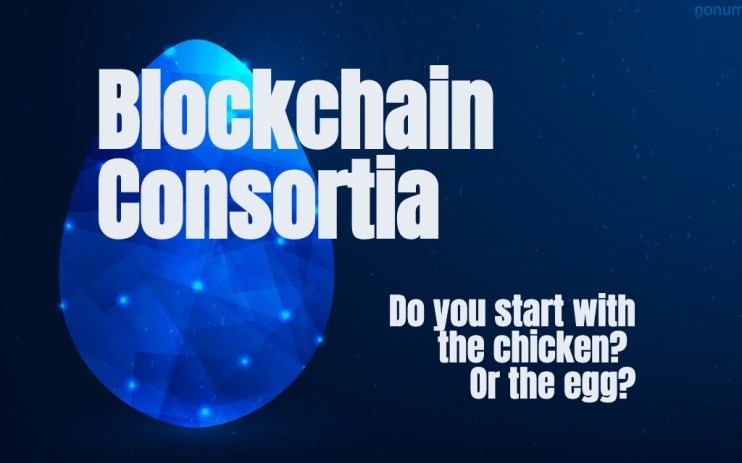Consortia: Chicken or Egg?

Building a blockchain or distributed ledger technology (DLT) solution adds no value if there is only a single benefactor. The most impactful solutions involve multiple stakeholders. In most cases, many of the enterprises are competitors who have agreed to work together to solve a common industry problem – or exploit a new business model.
But there is no obvious answer to the question: Where do you start?
Is the first step to build the solution and then build a consortium and ecosystem around the solution? Or do you create the consortium first and then make the solution? As with many new concepts, it comes down to the question: Is it the chicken first, or is it the egg?
And before you get to the “chicken or egg” question, start by identifying the problem or opportunity to be exploited.
The value in blockchain and DLT solutions come from the data stored in the blockchain. The data can reduce or eliminate the need for reconciliation. Or it can reduce the need for intermediaries and third parties. Data in these projects can support audits – or artificial intelligence can use the data for training.
Start with looking for pain points in the business which are not unique to your business, but which affect multiple companies in the same way. Strategists can identify the value of collectively working to building an ecosystem of companies. And they can determine the value to the business of using a shared system.
Then come the objections:
“If I could solve this problem for us, we could use it as a competitive advantage. Why should we help anyone else solve this problem?”
“I can see how this might reduce our costs, but how does it help us grow the business?”
“It sounds like a good idea, but I don’t want to pay for something that might benefit a competitor.”
“New technology is risky enough when we do it ourselves. If we are going to have to work with other companies, it will be practically impossible.”
New technology is risky enough when we do it ourselves. If we are going to have to work with other companies, it will be practically impossible.
Does any of this sound familiar?
Two of the most prominent enterprise blockchain and DLT solutions in use today are the IBM Food Trust and TradeLens. In both cases, a single large enterprise leads the way. Walmart started the IBM Food Trust. And TradeLens was started by the Danish shipping company, Maersk. Both companies took the approach:
Find a problem. Build a solution. Create a consortium. Give the solution away.
It’s that last step – give it away – that often is the deal-breaker. And yet that is what both Walmart and Maersk did. Both Maersk and Walmart did the initial work to define the problem and build the solution with a long term vision of giving it away to be part of a network. They recognised that what they were creating would never generate any value unless many companies started using it. And they were clear that the investment they made would produce long term savings and value to the business.
They also understood that there were risks. There was a risk of not succeeding technically (relatively low risk), and there was a risk of not succeeding strategically in getting others to join (considerably higher risk). Even so, they proceeded.
The alternative to building the solution first and giving it away is to start by creating the consortium.
Initially, the consortium could be as few as three or five companies who come together to define the problem and the solution. Each of these founding member companies contributes to the development of the project. And each commits to publicly discussing the value created and savings made from there new solution.
However, anyone who has worked to build consortia knows all too well that they can become mired in endless meetings. Starting a consortium from scratch doesn’t generate incremental revenue, nor does it reduce costs. If the problem or opportunity is not sufficiently large, it is near impossible to get strategic alignment for cooperation. Years can be lost in quarterly meetings, just trying to get everyone to agree. Sometimes the agenda include minutiae like the colour of the logo or the name of the solution. It is much harder to start a blockchain or DLT project by first building the consortium.
I spoke last year to Jason Kelley, General Manager of IBM Blockchain Services and asked why there weren’t more blockchain projects. His answer was succinct and very telling, “No one wants to go first.”
Going first is risky. Going first hard. Going first is also how you gain market advantage.
No one wants to go first – except the leaders.
No one wants to go first – except the leaders.
With economic strain growing from the COVID-19 crisis and the potential for even more significant challenges around the Brexit outcome, there exist real opportunities for strategic alignment. Enterprises around the world are reassessing everything from their product and service offerings, to their supply chain stability and elasticity, to how their teams work in a decentralised way.
Now is an excellent time to look for challenges which are industry-wide where a central solution can add value to all participants.
Whether you choose the chicken (a fully functional solution to give away to the broader industry) or if you decide to start with the egg (creating a working group or consortium focused on a specific challenge or opportunity) the main thing is to start.
And if no one else is doing it, it’s your moment. It’s your moment to go first. It is your opportunity to be a leader.

Get in touch with us info@blockchainrookies.com / Twitter @igetblockchain
Troy Norcross, Co-Founder Blockchain Rookies